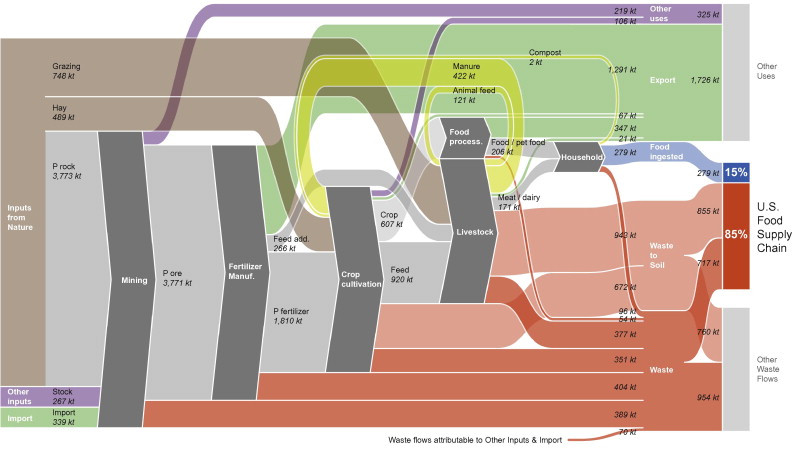[updated 5/7/2017]
Articles
Roy, E. D. (2017). Phosphorus recovery and recycling with ecological engineering: a review. Ecological Engineering, 98, 213-227. doi: 10.1016/j.ecoleng.2016.10.076
Bradford-Hartke, Z., Lane, J., Lant, P., & Leslie, G. (2015). Environmental benefits and burdens of phosphorus recovery from municipal wastewater. Environmental Science & Technology, 49(14), 8611-8622. doi: 10.1021/es505102v
“Overall, mineral depletion and eutrophication are well-documented arguments for phosphorus recovery; however, phosphorus recovery does not necessarily present a net environmental benefit.”
Kalmykova, Y., Harder, R., Borgestedt, H. and Svanäng, I. (2012), Pathways and Management of Phosphorus in Urban Areas. Journal of Industrial Ecology, 16: 928–939. doi: 10.1111/j.1530-9290.2012.00541.x
Liu H, Tang C, Li C. 2016. The effects of nitrogen form on root morphological and physiological adaptations of maize, white lupin and faba bean under phosphorus deficiency. AoB PLANTS 8: plw058; doi: 10.1093/aobpla/plw058
“Low phosphorus (P) availability in the soil is one of the most limiting factors for crop production (Schachtman et al. 1998 ; Lynch 2007). Plants have evolved different mechanisms in roots in order to increase P acquisition under P-limiting conditions.”
Steffen, W., Richardson, K., Rockström, J., Cornell, S., Fetzer, I., Bennet, E., Biggs, R., Carpenter, S., Vries, W., De Wit, C., Folke, C., Gerten, D., Heinke, J., Mace, G., Persson, L., Ramanathan, V., Reyers, B., & Sörlin, S. (2015). Planetary boundaries: Guiding human development on a changing planet. Science, 347(6223). doi: 10.1126/science.1259855
Brownlie, W., May, L., Mcdonald, C., Roaf, S., & Spears, B.M. (2014). Assessment of a novel development policy for the control of phosphorus losses from private sewage systems to the Loch Leven catchment, Scotland, UK. Environmental Science & Policy, 38, 207-216. doi: 10.1016/j.envsci.2013.12.006
Kanter, D. (2014). Returning to the planetary boundary for nitrogen: Science, economics and policy (Doctoral dissertation, Princeton University). Retrieved from http://www-static.cc.gatech.edu/~asb/thesis
Tuantet, K., Janssen, M., Temmink, H., Zeeman, G., Wijffels, R. H., & Buisman, C. J. (2013). Microalgae growth on concentrated human urine. Journal of Applied Phycology, 26(1), 287-297. doi: 10.1007/s10811-013-0108-2
Jaatinen, S., Lakaniemi, A., Rintala, J. (2015) Use of diluted urine for cultivation of Chlorella vulgaris. Environmental Technology, 37(9), 1159-1170. doi: 10.1080/09593330.2015.1105300
Fernandes, T. V., Shrestha, R., Sui, Y., Papini, G., Zeeman, G., Vet, L. E., . . . Lamers, P. (2015). Closing Domestic Nutrient Cycles Using Microalgae. Environmental Science & Technology, 49(20), 12450-12456. doi: 10.1021/acs.est.5b02858
Books
Richmond, A., & Hu, Q. (2013). Handbook of microalgal culture applied phycology and biotechnology. Oxford: Wiley-Blackwell.
Hackett, S. C. (1960). Environmental and Natural Resource Economics (4th ed.). Armonk, NY: M.E. Sharpe, Inc.
Weintraub, L. (2012). To Life! Eco Art in Pursuit of a Sustainable Planet. Berkeley and Los Angeles, CA: University of California Press.
Cohen, T. (2012). Telemorphosis: Theory in the Era of Climate Change, Vol. 1. Open Humanities Press. http://dx.doi.org/10.3998/ohp.10539563.0001.001
Morton, T. (2012). The ecological thought. Cambridge, MA: Harvard University Press.
Other
EPA Nutrient Policy: nitrogen and phosphorus data access tool
Blog/article: how the phosphorus shortage could leave us all hungry

http://www.sankey-diagrams.com/phosphorus-flows-in-the-u-s/
New ideas/vocabulary [wikipedia]
Industrial Ecology: The study of the human-influenced stocks and flows of resources and energy, from the perspective of resources and the environment
Eutrophication: Cultural eutrophication is a form of water pollution. Cultural eutrophication also occurs when excessive fertilizers run into lakes and rivers. This encourages the growth of algae (algal bloom) and other aquatic plants. Following this, overcrowding occurs and plants compete for sunlight, space and oxygen. Eutrophication arises from the oversupply of nutrients, which leads to over growth of plants and algae. After such organisms die, the bacterial degradation of their biomass consumes the oxygen in the water, thereby creating the state of hypoxia.
Material flows analysis: an analytical method to quantify flows and stocks of materials or substances in a well-defined system. MFA can also be applied to a single industrial installation, for example, for tracking nutrient flows through a waste water treatment plant. When combined with an assessment of the costs associated with material flows this business-oriented application of MFA is called Material Flow Cost Accounting. MFA is an important tool to study the circular economy and to devise material flow management.
Art/Design inspiration
- Air quality data jewelry
- Visualizing the non-renewable resources we have left
- Artscy materialists including Mel Chin‘s revival field and Operation PayDirt
- Edward Burtynsky landscape photography
- Diatoms
Experts [updated 5/7/2017]
I reached out to an David Kanter, an NYU professor who studies the nitrogen cycle and fertilizer, a UVM professor who studies phosphorus and has an ecological design lab, and a professor of industrial environmental management and solid waste at Yale School of Forestry and Environmental Studies (FES).
Interviews with David Kanter at NYU’s Environmental Studies department, who spoke with me at length about nutrient pollution, and Lauren Jabusch at UC Davis’ Department of Ecological and Environmental Engineering, who gave invaluable guidance and insight regarding algae, made my project this semester possible.
One Comment